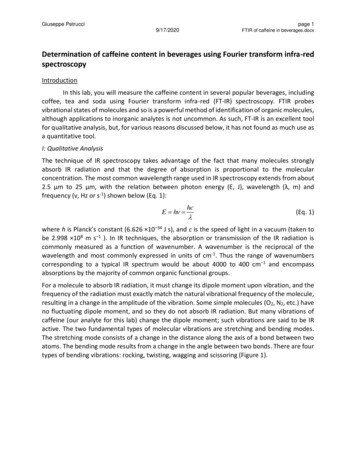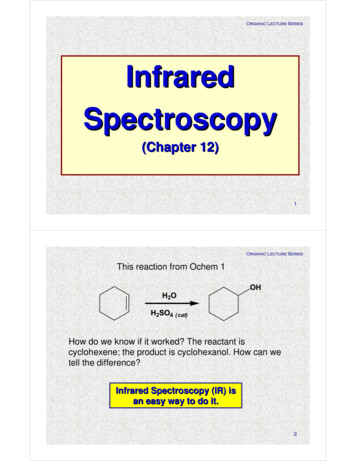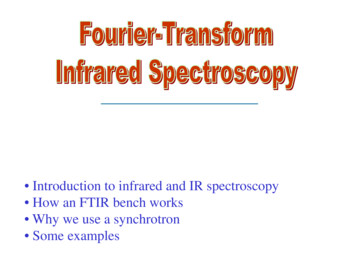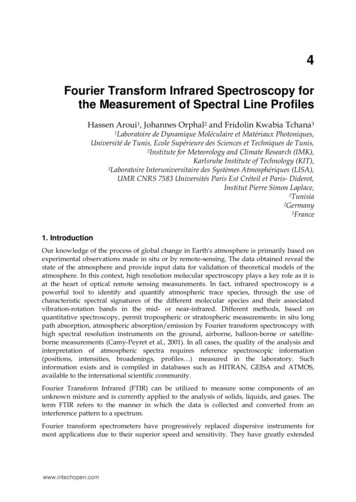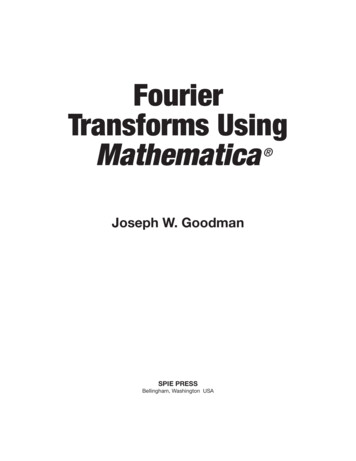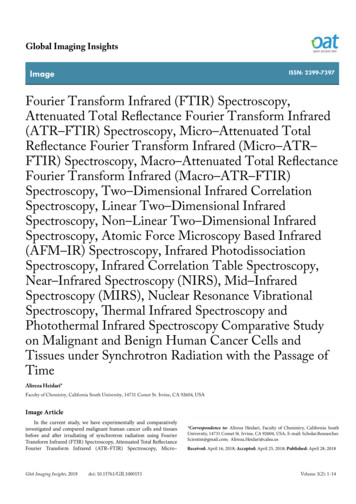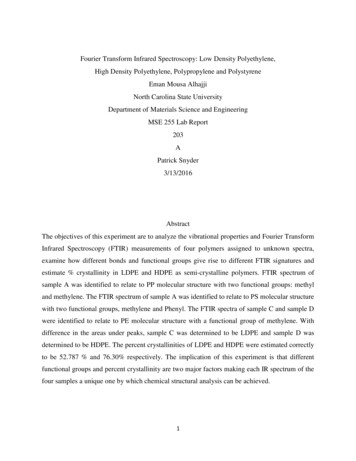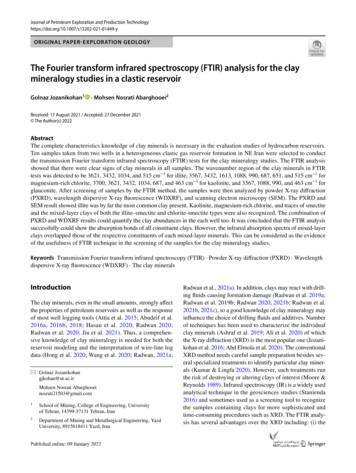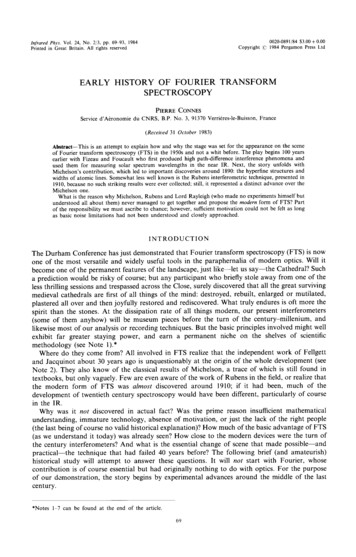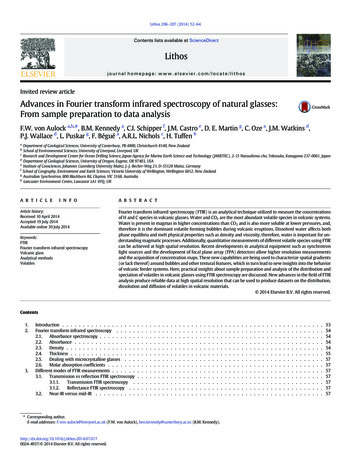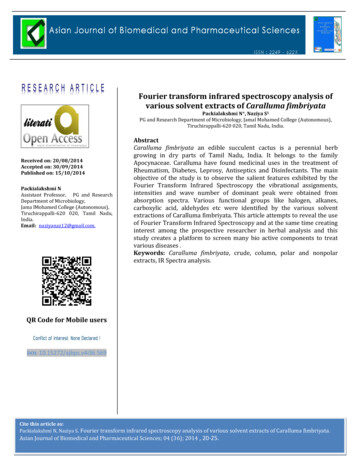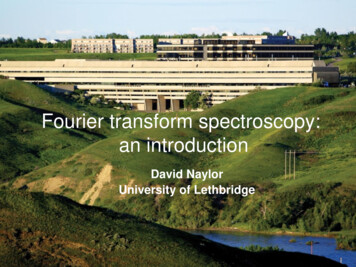
Transcription
Fourier transform spectroscopy:an introductionDavid NaylorUniversity of Lethbridge
Dunlap Institute Summer School 2015Fourier Transform Spectroscopy2
Outline HistoryIdeal vs real FTSPros/consExtension to iFTSExamplesDunlap Institute Summer School 2015Fourier Transform Spectroscopy3
Suggested readings on Fourier transform spectroscopyPapers provided:1.SHIFTS: Simulator for the Herschel Imaging Fourier Transform Spectrometer,John Lindnder MSc thesis excerpt (2006)2.Spectral Characterization of the Herschel SPIRE Photometer Locke Spencer MSc thesis excerpt (2005)3.Astronomical imaging Fourier spectroscopy at far infrared wavelengths, Can. J. Phys., Naylor et al (2013)4.Integral wide field spectroscopy in astronomy the iFTS solution, Experimental Astronomy, Maillard et al (2013)Introductory Textbooks:5.Eugene Hecht. Optics. Addison Wesley, fourth edition, (2002).6.P. R. Griffths and J. A. Haseth. Fourier Transform Infrared Spectrometry. John Wiley and Sons, New York, (1986).7.J. F. James, A students guide to Fourier transforms, Cambridge University Press (2002).Advanced Textbooks:8.R. J. Bell. Infrared Fourier Transform Spectroscopy. Academic Press, New York, (1972).9.Sumner P. Davis, Mark C. Abrams, and James W. Brault. Fourier Transform Spectroscopy. Academic Press, (2001).10. J. E. Chamberlain. The Principles of Interferometric Spectroscopy. John Wiley and Sons: Chichester, England (1979). Editedby G. W. Chantry and N. W. B. Stone.11. E. O. Brigham. The Fast Fourier Transform. Prentice-Hall Inc., (1974).12. M. Born and E. Wolf. Principles of Optics, Cambridge University Press, (1980).13. L. Mertz. Transformations in optics. New York: Wiley, (1965).14. D. C. Champeney. Fourier Transforms and their Physical Applications. Academic Press: St. Louis, MO (1973).15. R. M. Bracewell. Fourier Transforms and Its Applications. McGraw-Hill Book Co: New York, NY (1965).Dunlap Institute Summer School 2015Fourier Transform Spectroscopy4
Suggested readings on Fourier transform spectroscopyHistorical Papers:16. A. A. Michelson, On the application of interference methods to spectroscopic measurements. Phil. Mag., 34:280, (1892).17. H. Rubens & R. W. Wood, Focal isolation of long heat-waves. Philosophical Magazine, 21:249–261, (1911).18. H. Nyquist, Certain topics in telegraph transmission theory. Trans. American Inst. of Elec.Engn, 47:617 – 644, (1928).19. P. Fellgett.,A propos de la theorie du spectrometre interferentiel multiplex. Journal of Physics Radium, 19:187, (1958).20. P. Jacquinot, New developments in interference spectroscopy. Rep. Prog. Phys., 23:267–312, (1960).21. J Connes, Recherches sur la spectroscopie par transformation de Fourier, PhD Thesis, (1960).22. J. W. Cooley & J. W. Tukey, An algorithm for the machine calculation of complex Fourier series. Math. Comp., 19:297, (1965).23. M. L. Forman, Fast Fourier-Transform Technique and it’s Application to Fourier Spectroscopy. JOSA, 56(7):978, (1966).24. M. L. Forman, W. Steel & G. A. Vanasse, Correction of Asymmetric Interferograms Obtained in Fourier Spectroscopy. JOSA,56(1):59–64 (1966).25. L. Mertz, Rapid scanning Fourier transform spectroscopy. J. Phys. Coll. C2, Suppl. 3-4, 28:88, (1967).26. R. H. Norton & R. Beer, New apodizing functions for Fourier spectrometry. JOSA, 66:259 – 264, (1976).27. F. J. Harris, On the use of windows for harmonic analysis with the discrete Fourier transform. IEEE, 66, 51–83, (1978).Dunlap Institute Summer School 2015Fourier Transform Spectroscopy5
Coherence LengthThe coherence length, L, the optical delay length over which interferenceeffects can be observed is related to the bandwidth, Δλ, and the meanwavelength, λ0, of a source by:λ02L ΔλΔfCIn his search for the best optical emission line to be used as the standardof length, Michelson looked for sources that had the largest coherencelength, using the visibility curve:V(x) Imax IminImax IminWhere I is the fringe intensityExamples of coherence length of lasers Multimode He:Ne lasers have a typical coherence length of 20 cm Single mode He:Ne lasers are km Singlemode fibre lasers can exceed 100 km.Dunlap Institute Summer School 2015Fourier Transform Spectroscopy6
Ok, some mental arithmetic:What is coherence length of the visible lightemitted by an incandescent lamp?What is the bandwidth of laser that couldproduce a hologram of a small crater on themoon from a terrestrial laboratory?How challenging is this?Dunlap Institute Summer School 2015Fourier Transform Spectroscopy7
Michelson’s original FTSdesign and measurements(1892)Dunlap Institute Summer School 2015Fourier Transform Spectroscopy8
Michelson’s visibility measurements Dunlap Institute Summer School 2015Fourier Transform Spectroscopy9
Historical Background1890 - Michelson invented the interferometer, discovered several multipletsand found the red cadmium line to be extremely narrow. He determined thewavelength to unprecedented accuracy 6438.4696 Angstroms. It remainedthe standard of length until 1960!1911 - Rubens and Wood recorded the first interferogram.1949 - Fellgett performed the first computation of Fourier transform andrecognized the multiplex advantage of FTS.1950 - Jacquinot advantage recognized. Area x solid angle (throughput,étendue, light grasp) of an FTS much higher than dispersive spectrometers.1950 - 1965 FTS used only by those who could not obtain theirmeasurements by conventional spectroscopic techniques (Connes, Fellgett,Gebbie, Mertz).1965 - Cooley-Tukey (re) invented Fast Fourier Transform algorithm (FFT).Time to compute Fourier transform reduced from days to minutes.Over the last 50 years FTS have moved from the specialized domain of thephysics laboratory and are now found as standard diagnostic tools in manybranches of science and industry.Dunlap Institute Summer School 2015Fourier Transform Spectroscopy10
Diffraction GratingA diffraction grating is a plate with a periodic surface modulation –it creates multiple slit diffraction.Gratings can be designed for transmission, reflection, or phase operation.The diffraction peaks are wavelength sensitive – so with a white lightsource the maxima are associated with particular wavelengths (colours).Schematic of a reflection diffraction gratingDiffractedBeamInput BeamGN FNd sin sin m B BDunlap Institute Summer School 2015Constructive interference occurs when the opticalpath difference is an integer number of wavelengths:c.f. Young’ slits formulaGrating Equationa sin m m dFourier Transform Spectroscopy11
Fabry-Perot InterferometerA Fabry-Perot interferometer uses two highly reflecting plane parallel surfacesOne of the plates is set on a translation stage so that the gap, d, can be tuned for a particular wavelength or scanned to covera range of wavelengths.In reality several wavelengths are transmitted for a given gap, d: 2d0, 2d0/2, 2d0/3, .Filters are used to remove unwanted orders.This interference phenomena can be used to accurately measure distances by using a laser beam or in measuring the spectralnature of a source by scanning the separation so as to sequentially detect the intensity of different monochromatic components.Dunlap Institute Summer School 2015Fourier Transform Spectroscopy12
Michelson interferometerDunlap Institute Summer School 2015Fourier Transform Spectroscopy13
Michelson interferometerDunlap Institute Summer School 2015Fourier Transform Spectroscopy14
Michelson interferometerDunlap Institute Summer School 2015Fourier Transform Spectroscopy15
Michelson interferometerDunlap Institute Summer School 2015Fourier Transform Spectroscopy16
Michelson interferometerDunlap Institute Summer School 2015Fourier Transform Spectroscopy17
I ( z) B( ) exp(i ( )) exp( 2 i z ) d B(σ) I(δ) cos 2πσδ dδSpectrum, B, interferogram, I, wavenumber σ (cm-1), optical path difference, δ (cm)I′(δ) B(σ) exp(iφ(σ))exp(i2πσδ) dσφtotal φzpd φelectrical φoptical φrandomDunlap Institute Summer School 2015Fourier Transform Spectroscopy18
Dunlap Institute Summer School 2015Fourier Transform Spectroscopy19
SPIRE Test FTS atRutherford Appleton LaboratoryDunlap Institute Summer School 2015Fourier Transform Spectroscopy20
Dunlap Institute Summer School 2015Fourier Transform Spectroscopy21
Advantages of Fourier spectroscopy Relatively simple opto-mechanical design High throughput (Jacquinot) Simultaneous measurements of all wavelengths (Felgett) Intrinsic Wavelength calibration (Connes) Best instrumental line shape function of any spectrometerDisadvantages of Fourier spectroscopy Sensitivity to fluctuations in source intensity Multiplex disadvantage under background limited conditions Complex math required for analysisDunlap Institute Summer School 2015Fourier Transform Spectroscopy22
Key design considerations BeamsplitterMirror DriveMetrologyDynamic RangeMisaligned MirrorsDetector feed opticsChannel FringesDunlap Institute Summer School 2015Fourier Transform Spectroscopy23
Instrument Line Shape (ILS)Consider a monochromatic spectral line at frequency σ0B( ) 2 A L cos(2 0x) exp( i 2 x)dxL B( ) 2 A 0 cos 2 ( 0 ) x dx) 0 cos 2 ( 0 ) x dxLL sin 2 0 L sin 2 0 L B( ) 2 A 2 0 2 0 Rapidly decaysSinc ILSFirst zero of this function occurs at δσ 1/2LIn terms of FWHM δσ 1.207/2LDunlap Institute Summer School 2015Fourier Transform Spectroscopy24
Comparing Herschel SPIRE FTS ILS with theoryDunlap Institute Summer School 2015Fourier Transform Spectroscopy25
Line fitting Herschel SPIRE FTS spectraDunlap Institute Summer School 2015Fourier Transform Spectroscopy26
Dunlap Institute Summer School 2015Fourier Transform Spectroscopy27
But some people are never happy .Dunlap Institute Summer School 2015Fourier Transform Spectroscopy28
Dunlap Institute Summer School 2015Fourier Transform Spectroscopy29
Dunlap Institute Summer School 2015Fourier Transform Spectroscopy30
Optimal apodizing functionsNaylor and Tahic, Apodizing functions for Fourier transform spectroscopyJOSA A (2007)Dunlap Institute Summer School 2015Fourier Transform Spectroscopy31
Dunlap Institute Summer School 2015Fourier Transform Spectroscopy32
Phase correctionGoal: to correct for phase errors that arise from electrical, opticaland sampling effects.Method: convolve interferogram with phase correction function(PCF) derived from phase information extracted from a shortdouble-sided portion of the interferogram.PCF(δ) exp(-iφ(σ))exp(i2πσδ) dσIsymmetrical(δ) I(δ) * PCF(δ)Dunlap Institute Summer School 2015Fourier Transform Spectroscopy33
Raw asymmetrical interferogramDunlap Institute Summer School 2015Fourier Transform Spectroscopy34
RealDunlap Institute Summer School 2015ImaginaryFourier Transform SpectroscopyPhase35
Phase correction functionDunlap Institute Summer School 2015Fourier Transform Spectroscopy36
Raw asymmetrical interferogramDunlap Institute Summer School 2015Fourier Transform Spectroscopy37
Phase corrected symmetrical interferogramDunlap Institute Summer School 2015Fourier Transform Spectroscopy38
RealDunlap Institute Summer School 2015ImaginaryFourier Transform SpectroscopyPhase39
Generic FTS Control Instrument diagnosticsInterferogramProcessing Observing diagnostics Inspect interferogram De-glitch interferogram Re-grid interferogram Phase correctionSingleSidedFTDoubleSidedFT Gain correction Gain correction Wavelength correction Wavelength correction Code FT in C or JAVA,optimize for speed Code FT in C or JAVA,optimize for speed Flat fieldingSpectralProcessing Quality control Spectral Math – average, co-add, difference, etc.ArchivingVisualization Design SQL database for spectra / interferograms /observational parameters Slicing, thresholding, template/pattern matching,3-color mapping, profiling, averaging, etc.Dunlap Institute Summer School 2015Fourier Transform Spectroscopy40
The FTS is readily adapted to imaging spectroscopy - iFTSDunlap Institute Summer School 2015Fourier Transform Spectroscopy41
Imaging FTS Combine FTS with detector array Imaging Spectroscopy 3D data product 2D spatial imaging 1D spectralDunlap Institute Summer School 2015Fourier Transform Spectroscopy42
Imaging spectroscopyAn imaging Fourier Transform Spectrometer (iFTS)Dunlap Institute Summer School 2015Fourier Transform Spectroscopy43
The IFTS SystemDunlap Institute Summer School 2015Fourier Transform Spectroscopy44
IFTS Graphical User Interface (GUI)Dunlap Institute Summer School 2015Fourier Transform Spectroscopy45
Imaging spectroscopy with a Mach-Zehnder iFTSDunlap Institute Summer School 2015Fourier Transform Spectroscopy46
EvenI out1 ( z ) S A{RTcos[2 ( )]cos[ 2 z ]}d S A{RT sin[ 2 ( )]sin[ 2 z ]}d S B {RT cos[ 2 z ]}d S BS { RT cos[ ( )] cos[ 2 z ]}d S BS { RT sin[ ( )] sin[ 2 z ]}d I out 2 ( z ) S A{RTcos[ 2 z ]}d S B {RT cos[2 ( )]cos[ 2 z ]}d S B {RT sin[ 2 ( )]sin[ 2 z ]}d OddDunlap Institute Summer School 2015 S BS { RT cos[ ( )] cos[ 2 z ]}d S { RT sin[ ( )] sin[ 2 z ]}d 47BSFourier TransformSpectroscopy
iFTS data processing pipeline modules Inspect interferogram data cubes Deglitch cosmic ray events Phase correction Apodization Fourier transform time sampled interferograms Wavelength scale correction for off-axis pixels (the obliquity effect) Flat field array – adjust gain for individual pixel responsivities Calibrate spectra in Jy or W m-2 Hz-1 Inspect spectral data cubes Merge spectral data cubes from two bands Spectral processing (average, difference, ratio, spectral/spatial integration)Dunlap Institute Summer School 2015Fourier Transform Spectroscopy48
iFTS scan of a uniform white targetDunlap Institute Summer School 2015Fourier Transform Spectroscopy49
Imaging spectroscopy of something found in everywell equipped physics research laboratory .Smarties!Dunlap Institute Summer School 2015Fourier Transform Spectroscopy50
Dunlap Institute Summer School 2015Fourier Transform Spectroscopy51
Now we have complete spectral information for each pixelFTS Array Detector Dunlap Institute Summer School 2015Hyperspectral ImagingFourier Transform Spectroscopy52
Or if we prefer we can fly through the spectral hypercube viewinga spatial image as a function of wavelength Dunlap Institute Summer School 2015Fourier Transform Spectroscopy53
Dunlap Institute Summer School 2015Fourier Transform Spectroscopy54
Dunlap Institute Summer School 2015Fourier Transform Spectroscopy55
Dunlap Institute Summer School 2015Fourier Transform Spectroscopy56
Dunlap Institute Summer School 2015Fourier Transform Spectroscopy57
KLSBarDunlap Institute Summer School 2015Fourier Transform Spectroscopy58
Dunlap Institute Summer School 2015Fourier Transform Spectroscopy59
Dunlap Institute Summer School 2015Fourier Transform Spectroscopy60
Dunlap Institute Summer School 2015Fourier Transform Spectroscopy61
Poor S/N is not always a showstopper Dunlap Institute Summer School 2015Fourier Transform Spectroscopy62
Berlin, 22 Nov 1880(Michelson to Simon Newcomb) With alldue respect, however, I think differently,for if the apparatus is surrounded withmelting ice, the temperature will be sonearly constant as possible.There is another and unexpected difficulty,which I fear will necessitate thepostponement of the experimentsindefinitely – namely – that the necessaryfunds do not seem to be forthcoming.Newcomb arranged for AlexanderGraham Bell to provide the 100 tobuy the optical componentsfor Michelson’s interferometer, and therest is historyDunlap Institute Summer School 2015Fourier Transform Spectroscopy63
What his contemporaries thoughtWhile visiting the Nautical Almanac Office in 1879 Michelson read aletter from James Clerk Maxwell to the director in which he stated hisbelief that no terrestrial experiment could be designed with sufficientsensitivity to measure the motion of the earth through the aether.(Nature, 21 314, (1880))I always think of Michelson as the artist in Science. His greatest joyseemed to come from the beauty of the experiment itself, and theelegance of the method employed. There is of course, no logicalway to the establishment of a theory, but only groping constructiveattempts controlled by careful consideration of factual knowledge.(Nature, 171 101, (1953)) Albert EinsteinDunlap Institute Summer School 2015Fourier Transform Spectroscopy64
Writing about the Durham FTS Conference Sept 1983 Connes wrote:(The conference) has just demonstrated that Fourier transformspectroscopy is now one of the most versatile and widely useful tools inthe paraphernalia of modern optics. Will it become one of thepermanent features of the landscape, just like - let us say - theCathedral? Such a prediction would be risky of course; but anyparticipant who briefly stole away from one of the less thrilling sessionsand trespassed across the Close, surely discovered that all the greatsurviving medieval cathedrals are first of all things of the mind:destroyed, rebuilt, enlarged or mutilated, plastered all over and thenjoyfully restored and rediscovered. What truly endures is oft more thespirit than the stones. At the dissipation rate of all things modern, ourpresent interferometers (some of them anyhow) will be museum piecesbefore the turn of the century-millenium, and likewise most of ouranalysis or recording techniques. But the basic principles involvedmight well exhibit far greater staying power, and earn a permanentniche on the shelves of scientific methodology.
Dunlap Institute Summer School 2015Fourier Transform Spectroscopy66
Dunlap Institute Summer School 2015Fourier Transform Spectroscopy67
Dunlap Institute Summer School 2015Fourier Transform Spectroscopy68
Questions?Dunlap Institute Summer School 2015Fourier Transform Spectroscopy69
Astronomical imaging Fourier spectroscopy at far infrared wavelengths, Can. J. Phys., Naylor et al (2013) 4. Integral wide field spectroscopy in astronomy the iFT
